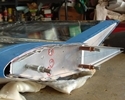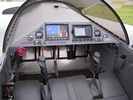


random user submitted photo
Todd's canopy
8 posts
• Page 1 of 1
Todd's canopy
Anyone have any experience with a Todd's canopy in the sonex? I haven't been able to find much, but a couple people have said that there is less side-to-side headroom than the standard canopy. I'm not sure how that could be - it looks to be much roomier overall. His customers seem very pleased. Anyone have one on their sonex and care to report?
Mike L
Sonex #1345
Tail complete
Working on wings
Sonex #1345
Tail complete
Working on wings
- samiam
- Posts: 209
- Joined: Thu Oct 03, 2013 7:24 am
- Location: S37
Re: Todd's canopy
One point: The standard canopy and windscreen uses a Lexan (flat-wrapped) windscreen and an acrylic canopy. The Todd's canopy and windscreen is all acrylic. Because it is "blown" all at once and then cut, the Todd's canopy generally has a nice, continuous "line" when viewed in profile. This is hard (but not impossible) to achieve using the standard construction method.
There's a significant difference in impact tolerance between acrylic and Lexan (polycarbonate). They are both clear and they both look about the same, but they behave very differently when hit. If a bird should ever become very big in your windscreen, this could be important.
-- This thread on the Homebuilt Airplane board gives a great description of how one RV-8 builder modified the "stock" blown acrylic windscreen with a flat-wrapped polycarbonate windscreen. (Subsequent edit: Charlie Radford correctly points out that the RV-8 builder used plexiglas, not Lexan for his new windshield. True, I missed that.) http://www.homebuiltairplanes.com/forums/aircraft-design-aerodynamics-new-technology/11740-rv-8-windshield-mod-2.html. He did this after several birds entered his cockpit and nearly blinded him after coming through the acrylic windscreen. Three quail at about 165 knots--in fairness, that's a lot faster than most of us go. Good photos at the above link of the hole left by the birds.
There are some fairly well-done videos on the web comparing the impact resistance of acrylic to Lexan. Lexan "gives" a lot more, whereas at the same stress levels acrylic will crack/fracture. Here's a video of acrylic and Lexan motorcyle windscreens being subjected to some impacts. It's not scientific, but it is an attention-getter. http://www.youtube.com/watch?feature=player_embedded&v=HlEfJFDWXpM
Many people really like their Todd's canopies and have been flying with them successfully for years. I'm satisfied with my "stock" windscreen and canopy.
There's a significant difference in impact tolerance between acrylic and Lexan (polycarbonate). They are both clear and they both look about the same, but they behave very differently when hit. If a bird should ever become very big in your windscreen, this could be important.
-- This thread on the Homebuilt Airplane board gives a great description of how one RV-8 builder modified the "stock" blown acrylic windscreen with a flat-wrapped polycarbonate windscreen. (Subsequent edit: Charlie Radford correctly points out that the RV-8 builder used plexiglas, not Lexan for his new windshield. True, I missed that.) http://www.homebuiltairplanes.com/forums/aircraft-design-aerodynamics-new-technology/11740-rv-8-windshield-mod-2.html. He did this after several birds entered his cockpit and nearly blinded him after coming through the acrylic windscreen. Three quail at about 165 knots--in fairness, that's a lot faster than most of us go. Good photos at the above link of the hole left by the birds.
There are some fairly well-done videos on the web comparing the impact resistance of acrylic to Lexan. Lexan "gives" a lot more, whereas at the same stress levels acrylic will crack/fracture. Here's a video of acrylic and Lexan motorcyle windscreens being subjected to some impacts. It's not scientific, but it is an attention-getter. http://www.youtube.com/watch?feature=player_embedded&v=HlEfJFDWXpM
Many people really like their Todd's canopies and have been flying with them successfully for years. I'm satisfied with my "stock" windscreen and canopy.
Last edited by vigilant104 on Sat Nov 02, 2013 8:23 pm, edited 2 times in total.
Mark Waldron
Sonex 1230 (Builder: Jay Gibbs)
Aerovee, Trigear
Sonex 1230 (Builder: Jay Gibbs)
Aerovee, Trigear
- vigilant104
- Posts: 265
- Joined: Wed Nov 09, 2011 3:34 pm
- Location: Near Dayton, OH
Re: Todd's canopy
I agree with Mark 100%. I've had several close calls with large birds and even though I haven't hit one (yet), I like the increased safety factor of the Lexan.
Also, this is completly my own opinion, but I'm not in love with the "bubble" shape of Todd's canopy. I prefer the stock look with a (profile view) straight line from the cowling into the front windshield into the canopy, as opposed to the popped up windscreen.
That being said, there are a lot of people who are very happy with their Todd's Canopy. I know of several RV guys who have one and love it. I can't remember for certain but seem to recall that if you want a custom canopy with a specified shape, Todd's people can custom make you a canopy. Always nice to have that option!
Good luck!
Also, this is completly my own opinion, but I'm not in love with the "bubble" shape of Todd's canopy. I prefer the stock look with a (profile view) straight line from the cowling into the front windshield into the canopy, as opposed to the popped up windscreen.
That being said, there are a lot of people who are very happy with their Todd's Canopy. I know of several RV guys who have one and love it. I can't remember for certain but seem to recall that if you want a custom canopy with a specified shape, Todd's people can custom make you a canopy. Always nice to have that option!
Good luck!
Mike Farley
Waiex #0056 - N569KM (sold)
Onex #245
Waiex #0056 - N569KM (sold)
Onex #245
- MichaelFarley56
- Posts: 1485
- Joined: Thu Jun 02, 2011 11:38 pm
- Location: Columbus, Ohio
Re: Todd's canopy
vigilant104 wrote: -- This thread on the Homebuilt Airplane board gives a great description of how one RV-8 builder modified the "stock" blown acrylic windscreen with a flat-wrapped polycarbonate windscreen.
In the article he said he used "plexi"...which I took to mean plexiglas. Plexiglas is also an acrylic sheet.
http://www.plexiglas.com/en/
- radfordc
- Posts: 573
- Joined: Fri Jun 03, 2011 9:39 am
Re: Todd's canopy
radfordc wrote:vigilant104 wrote: -- This thread on the Homebuilt Airplane board gives a great description of how one RV-8 builder modified the "stock" blown acrylic windscreen with a flat-wrapped polycarbonate windscreen.
In the article he said he used "plexi"...which I took to mean plexiglas. Plexiglas is also an acrylic sheet.
http://www.plexiglas.com/en/
Charlie,
Thanks, good catch. He used plexiglass (acrylic), but increased the thickness. I amended my earlier post.
One other advantage of the Lexan flat-wrap approach compared to an acrylic windshield-and-canopy: If you need a new windshield someday it can be done by itself without needing to replace the canopy, too. That's a consideration if a splash of fuel should ever find it's way from the oh-so-close filler and onto the windscreen. Of course, it's best to avoid that.
Mark Waldron
Sonex 1230 (Builder: Jay Gibbs)
Aerovee, Trigear
Sonex 1230 (Builder: Jay Gibbs)
Aerovee, Trigear
- vigilant104
- Posts: 265
- Joined: Wed Nov 09, 2011 3:34 pm
- Location: Near Dayton, OH
Re: Todd's canopy
Good point. I'm on my third windshield now. The downside of Lexan is that it scratches relatively easy...but it's cheap and fast to make a replacement.
- radfordc
- Posts: 573
- Joined: Fri Jun 03, 2011 9:39 am
Re: Todd's canopy
I have todd's canopy and I absolutely love it. The clarity is impeccable and I have abused the hell out of it and not a single crack yet. I cut the canopy to size with an angle grinder with a blade made for cutting plastics. I would highly recommend it. As far as the bird strikes I call BS on that! I have bent a scrap piece in near half trying to break it to put in the trash and had a hard time. I think it comes down to what look you like better and whether you want to roll the dice on breaking a pricey item.
Eric M
Eric M
- Sonex825
- Posts: 28
- Joined: Sun Feb 12, 2012 1:06 am
8 posts
• Page 1 of 1
Who is online
Users browsing this forum: No registered users and 81 guests







